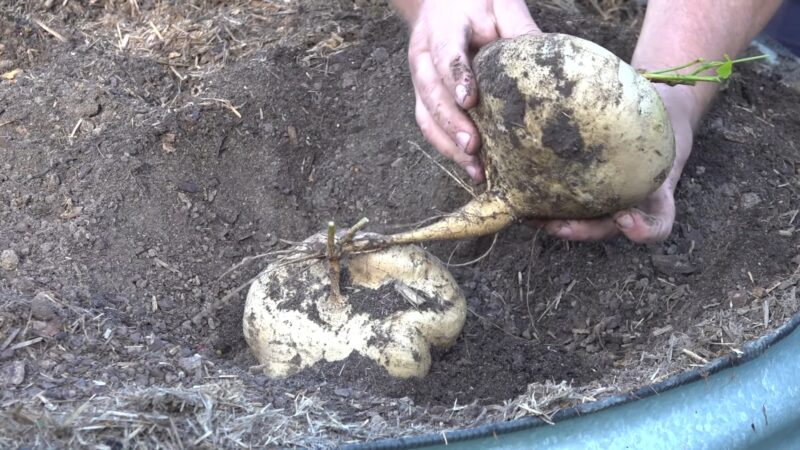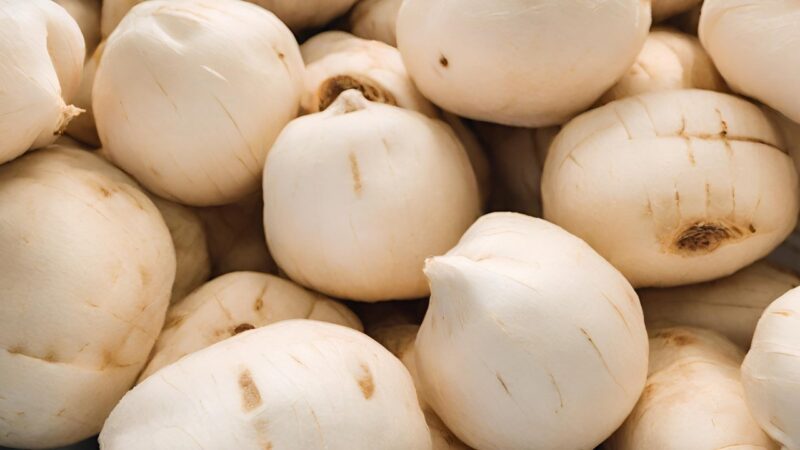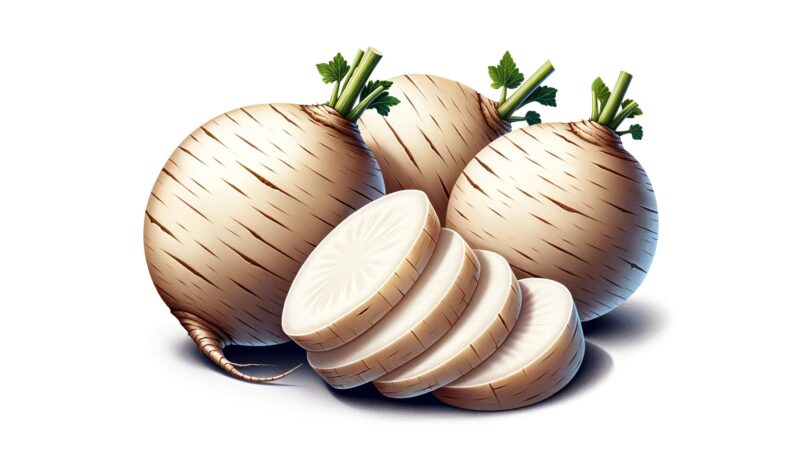Jicama, a root vegetable native to Mexico, is a culinary delight cherished for its crisp texture and sweet, nutty flavor. Often used in salads, salsas, and stir-fries, it’s essential to store jicama correctly to maintain its freshness and nutritional value.
This guide provides a detailed approach to storing this vegetable correctly, ensuring it remains a vibrant and healthy addition to your meals.
Selecting and Preparing Jicama

How to Choose the Right Jicama
Selecting the best jicama is crucial for both taste and storage longevity. Look for jicamas that are firm to the touch, have dry skin, and are free from blemishes or soft spots.
The ideal jicama should feel heavy for its size, indicating a good water content, which is a sign of freshness. Avoid vegetables that show any signs of mold or excessive softness, as these may have already begun to spoil.
Preparing for Storage
Before storing, it’s important to clean the vegetables under running water to remove any surface dirt or contaminants. However, resist the urge to peel it until you’re ready to use it, as the skin is crucial in preserving its freshness during storage.
After washing, dry the jicama thoroughly to prevent moisture accumulation, which can lead to spoilage.
Initial Storage Steps
For immediate use within a week, jicama can be stored at room temperature in a cool, dry place, away from direct sunlight. If you plan to keep it longer, refrigeration is the best option.
These initial steps are vital in extending the shelf life of the vegetable, keeping it fresh and crisp for your culinary creations.
Long-Term Storage Solutions
Refrigeration Tips
When it comes to refrigerating this vegetable, the crisper drawer of your refrigerator is the ideal spot. This compartment maintains a consistent temperature and humidity level, which is crucial for preserving jicama’s freshness.
Store the vegetable in a perforated plastic bag to facilitate slight air circulation, preventing moisture buildup while keeping it sufficiently hydrated. With this method, jicama can remain fresh for up to three weeks, retaining its crispness and flavor.
Freezing the Vegetable
For those looking to store the vegetable for several months, freezing is a viable option. Begin by peeling and slicing the jicama.
Blanch the slices in boiling water for a few minutes to preserve their texture and color, then immediately cool them in ice water. Dry the slices thoroughly to prevent ice crystal formation before placing them in airtight containers or freezer bags.
While frozen vegetables might lose some of their crisp texture, it’s still excellent for cooked dishes.
Handling Cut Jicama
Once you cut the vegetable, it requires different storage conditions. The exposed flesh can dry out or spoil quickly.
To prevent this, wrap the cut surface with plastic wrap or place it in an airtight container and refrigerate. Ideally, consume cut jicama within a week to enjoy its best quality.
Regularly inspect it and use any parts showing signs of spoilage immediately to avoid wasting the whole vegetable.
Advanced Storage Tips
Control Humidity!
Jicama’s longevity is significantly influenced by humidity levels. While too much moisture can lead to rot, insufficient humidity can cause it to become dry and tough.
In the refrigerator, the crisper drawer usually provides the ideal humidity for the vegetable. If storing at room temperature, choose an area with good air circulation to prevent moisture accumulation.
Ethylene Sensitivity
Being sensitive to ethylene gas, it’s important to store the vegetable away from fruits like apples and bananas, which emit this ripening agent. Ethylene can hasten the aging process of jicama, leading to premature spoilage.
Storing it separately ensures it remains fresh for a longer duration.
Regular Checks
Conduct periodic inspections of your stored jicama. Look for any signs of spoilage, such as soft spots or an unpleasant odor.
If detected early, you can often use the unaffected parts of the jicama and prevent the whole vegetable from going bad. This habit is crucial in maintaining the quality of the vegetable over time.
Common Mistakes to Avoid

Overbuying
Purchasing this vegetable in large quantities might seem economical, but it can lead to waste if you’re unable to use it all before it spoils. Buy amounts that you can realistically consume within a few weeks to avoid unnecessary wastage.
Ignoring Temperature Fluctuations
Jicama is sensitive to temperature changes. Storing it near heat sources like ovens or in direct sunlight can lead to premature spoilage.
Similarly, placing it in overly cold spots can damage its texture. Thus, finding a location with a stable, cool temperature is essential for proper storage.
Delaying Usage
While jicama can be stored for extended periods, its quality is highest shortly after purchase. Try to plan your meals to use the vegetable within a few weeks of buying it.
This practice ensures you enjoy its peak flavor and nutritional benefits.
Health Benefits
Digestive Health
Jicama is rich in dietary fiber, which is beneficial for digestive health. Regular consumption of this vegetable can help maintain a healthy digestive system, preventing constipation, and promoting a feeling of fullness, aiding in weight management.
Immune System Support
High in vitamin C, this vegetable supports the immune system. This nutrient is vital for the body’s healing process and helps in the maintenance of healthy skin and bones.
Blood Sugar Regulation
The fiber in this vegetable also plays a role in regulating blood sugar levels. It slows down the absorption of sugar in the bloodstream, making it a suitable choice for individuals managing diabetes or looking to maintain stable blood sugar levels.
FAQs
Can jicama be pickled for longer storage?
Absolutely. Pickling the vegetable in a vinegar-based solution can extend its shelf life significantly and also add a flavorful twist to the vegetable, making it a great addition to salads and sandwiches.
Can I store jicama with other root vegetables like potatoes and carrots?
Yes, you can store it with other root vegetables such as potatoes and carrots. However, it’s important to keep them in separate compartments or bags to prevent the transfer of moisture and ethylene gas, which can affect their respective shelf lives.
Is it possible to revive slightly wilted jicama?
Slightly wilted vegetables can often be revived by soaking them in cold water for a few hours. This process can help restore its crispness. However, this method may not be effective if the jicama is significantly wilted or shows signs of spoilage.
How can I tell if stored jicama has gone bad?
The vegetable will often have soft spots, a slimy texture, and a sour or off smell. If the inside appears brown or discolored and the texture is mushy, it’s best to discard it.
Does the size of the jicama affect its storage life?
Yes, the size can affect storage life. Smaller roots tend to have a shorter shelf life than larger ones due to a higher ratio of skin to flesh, which can lead to faster moisture loss and spoilage.
Are there any specific conditions to avoid when storing jicama?
It’s important to avoid storing the vegetables in overly damp or very dry environments. Excessive humidity can lead to rot, while very dry conditions can cause them to dehydrate and harden. Also, avoid storing it near heat sources or in direct sunlight.
Summary
Jicama is a delightful addition to your culinary repertoire, but proper storage is essential to enjoy its full benefits. By selecting quality vegetables, preparing them correctly, and following these storage guidelines, you can extend their shelf life and maintain their nutritional value.
Whether you’re a seasoned cook or new to this versatile vegetable, understanding how to store jicama is a valuable skill that will enhance your meals and reduce food waste. Remember, the key to storing this vegetable lies in choosing the right environment, monitoring its condition, and being mindful of common storage pitfalls.
With these insights, you’re well-equipped to keep your jicama fresh, crisp, and ready for your next delicious creation.

